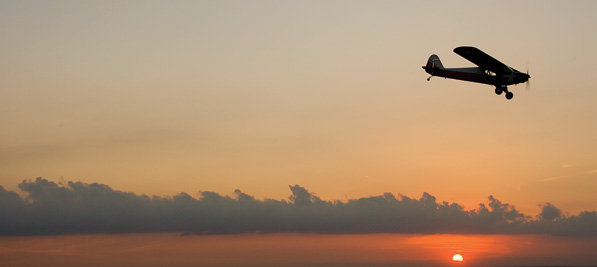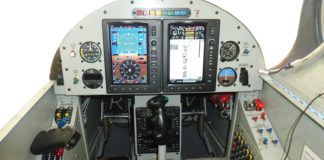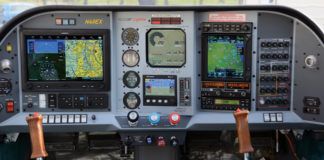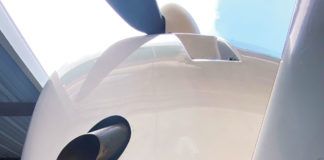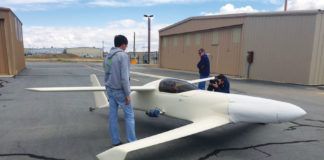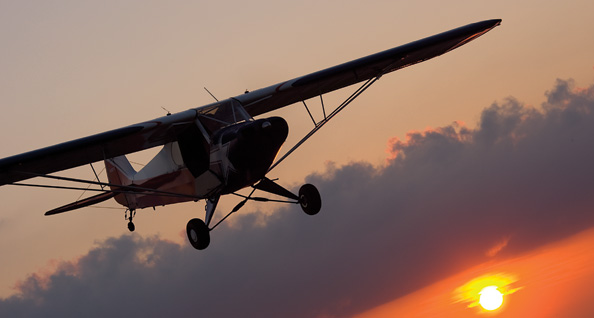
A common thread in the letters, emails and phone calls we receive at KITPLANES is this: The kit aircraft you cover are too expensive. Nobody has $100,000 to drop on an airplane these days. You need to focus on the lower end of the market!
As the U.S. and world economies stagger back to life—slower than our tax-refund checks—and the furrows on the foreheads of the kit manufacturers gradually smooth out, it is reasonable to look at the modest-budget end of the market. Could these aircraft make up their own branch of the Experimental Stimulus Package? (We just made that up.) Are low-cost aircraft the lighter fluid on our hibachi of recovery?
Why the arbitrary limit of $35,000? Well, that’s about what a nicely equipped full-size sedan costs, and it’s in the realm of what it would take to buy a decent used certified aircraft that’s not just old enough to vote but sufficiently mature to worry about the future of social security. We set the price at what seems reasonable to complete the airplane—though your definition might have to be flexible. For the lowest cost examples, you will get a fully furnished plane.
At this price level, you’ll be making some sacrifices. Naturally, don’t expect most of these airplanes to be do-it-all utility or continent-spanning travelers. For the most part, designs that inhabit this cost stratum are low-speed, sunny-day machines; some are two-seaters, but others have just the one perch. Smaller airplanes generally cost less for a variety of reasons: reduced quantity of materials, sure, but largely because they can be happy with less powerful engines. The powerplant is a big portion of any project’s budget, and it plays an even more prominent role here—that’s why many of these designs use low-cost two-cycle engines. Those that don’t will likely require you to find a suitable used (or able to be overhauled) larger engine.
Finally, consider this collection of 11 an exercise of what can be done; certainly, it’s not an exhaustive list. There are other designs in this cost category that we admire, and their omission isn’t an indication that we love them any less.
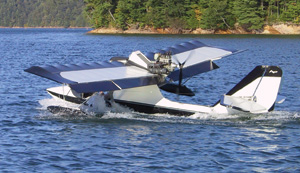
Aero Adventure Aventura HP
The Aero Adventure Aviation Aventura HP is the son of a Buccaneer, the Part 103 ultralight machine of the 1980s, that is. Even back then, the object was to bring amphibious flying to pilots on a budget. There is also a two-seat version, the Aventura II, and an ultralight, the Aventura UL. The single-seat HP supports engines of up to 65 hp and fuel capacity of up to 18 gallons (with optional tank), yielding a possible range of up to 250 miles. This being a high-wing, pusher design, visibility is virtually unobstructed, which is a great asset for an amphibian. The one-piece hull is composite, and the design meets the requirements for Light Sport Aircraft designation. Forward in the hull is a small area for storage.
Empty weight is 390 pounds, and gross is 950. Cruise at 75% power is given as 75 mph, rate of climb at gross is 700 to 1000 fpm. The standard engine option is a Rotax 503, but horsepower can range from 50 to 80. Base kit price without engine is $18,995, and the estimated completed cost is $19,000 to $25,000 (the low end assuming an other-than-new engine). Estimated build time is 200 hours.
Options for an amphibious kit aircraft are relatively few, so the Aventura HP is one way for sea-minded pilots to get out on the water for the price of a similarly equipped non-amphib. Aventura keeps its design simple but effective, and the price of the kit illustrates this.
www.sea-plane.com
321/635-8005
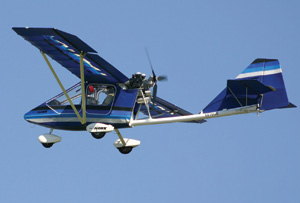
CGS Aviation Hawk Arrow
CGS Aviation, an outgrowth of the original Chuck’s Glider’s Supplies, named for longtime homebuilt purveyor Chuck Slusarczyk, offers a number of designs for budget-minded pilots. The Hawk Arrow is an updated version of the company’s Hawk Classic, and is a single seat, pusher-engine, high-wing, Dacron fabric-covered ultralight-type product. A curved overhead and windshield give it a more modern look than the rounded Classic. The basic kit is $17,803 and includes the Rotax 503 engine.
Engine options include the two-stroke 40-hp Rotax 447, 50-hp Rotax 503, 65-hp Rotax 582 and 65-hp, four-stroke HKS 700E. Various options include hard doors, tinted Lexan windows, BRS ‘chute and a wing/tail folding package.
Even with a low fuel burn rate (depending on the engine), the 10-gallon fuel capacity, cruise speed of 65 mph and a somewhat open cockpit make this an impractical cross-country machine. However, for a price that’s less than that of some new cars and a relatively short assembly time estimated at 300 hours, one could have a modest and thoroughly enjoyable entry to seasonal sport flying.
www.cgsaviation.com
251/957-4295
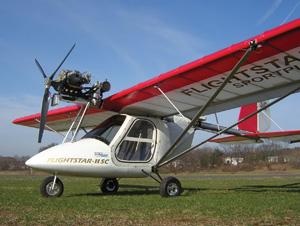
Flightstar IISC
Flightstar may be a relatively new name to some in the homebuilt world, but its progenitor’s name likely isn’t. Tom Peghiny has been involved in aviation for decades, starting with his hang gliding successes in the 1970s. The Flightstar has taken his compendium of experiences and molded a design that retains the best aspects of sport flying but offers greater flexibility. The two-seat IISC is the “Sport Cabin” version of the IISL, with an enclosed cockpit for comfort during the “off season.” Its high wing is fabric covered, and the engine is mounted on top in front.
Engine options include the Rotax 503 with Flightstar’s supercowl, the Rotax 582 water-cooled engine and the HKS 700E. Flightstar kits come complete enough that no component fabrication, drilling or finishing of the airframe is required, the company says. Basic kit prices, including engine, run about $24,000 for the 503 and $27,000 for the 582. A full instrument package is $755 and other options such as a complete electrical system, four-point harness upgrade, BRS ballistic parachute, in-flight trim system, X-ply Mylar upgrade and more are available. The company places the time required to complete the project at 150 hours.
Empty weight is 385 pounds, and gross is 950. Fuel capacity is 10 gallons, climb is 600 fpm, and cruise is 65 mph. Max range with 10 gallons of fuel is 200 miles.
Performance figures are comparable to other aircraft in this category, but with the instrument package and the fully enclosed cockpit, one might be tempted to venture farther afield in this airplane, though such journeys, especially with two people, may be limited by the baggage that can be carried.
www.fly-flightstar.com
860/963-2652
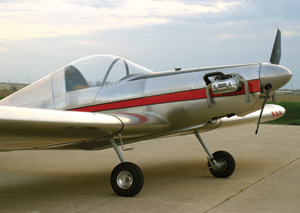
Hummel H-5
With the passing of the seemingly indefatigable Morry Hummel this year, the exquisite simplicity and rightness of line embodied in the Hummel H-5 is just a bit more stirring. A fanatic for low weight and elegant design, Hummel helped push the H-5 toward modern pilots—that’s a euphemism for those of us no longer 140 pounds dripping wet—with a more generous single-chair cabin. Indeed, the H-5 borrows from the Ultra Cruiser Plus, and provides a 105-knot (120-mph) cruise on 85 hp. It can be built to take a variety of Volkswagen-based engines, including those built by Great Plains, sister company of Hummel Aviation.
As we went to press, the first two full kits of the H-5 had been shipped at a cost of $16,000 per. Add, say, $6000 for the engine and a couple more Aviation Monetary Units for extras, and you’ve completed your sleek taildragger for less than $25,000. Even with the larger engine using 5 gph of auto gas, the per-hour costs of the H-5 ought to be less than a teenager’s texting bill. That the H-5 is a fine-handling, efficient performer only adds to the luster of Morry Hummel’s accomplishments.
www.flyhummel.com
419/636-6700
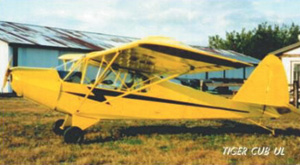
Johnston Aviation Tiger Cub UL
We’re highlighting the Johnston Aviation Tiger Cub UL because it has tremendous bang for the buck. This high-wing single-seater features a Rotax 447, and that choice helps the airplane come in for around $20,000 for the basic aircraft with engine. (Yet another glitch in our database: We had the Tiger Cub UL shown as $12,560 for the kit including engine. This is incorrect. The engine is not included for that price.) An option is the Rotax 503; the 447 is around $4500, and the 503 about $1500 more.
If your goal is to make our $35K limit, you can order all the options from Johnston—in the basic kit, all the materials are provided, and the method of construction using mainly aluminum members requires no welding. A quickbuild option is available with an engine as part of the package; $24,800 with the 447 and a prop, $25,800 with a 503 and prop. Even after you’ve added the Dacron covering and basic instruments, getting a Tiger Cub UL in below our self-imposed limit ought to be as easy as falling off a barstool.
www.tigercubaircraft.com
724/745-4040
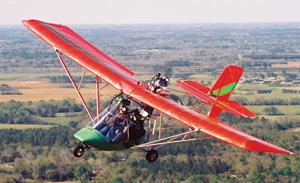
M-Squared Breese 2
The Breese 2 is a high-wing, two-place, open-cockpit aircraft that can be configured with either a single-surface wing (SS) that is suited for use with the aircraft on floats or a double-surface (DS) wing that allows faster flight. The kit price of $24,995 includes the engine, a Rotax 582, but it does not include items such as avionics, radios, an ELT or paint. This is the kit version of the factory-built aircraft, which sells ready-to-fly for $34,995. Features include a steel roll cage, center-mounted controls, an anti-vibration engine mount and bungee trim system.
Empty weight is 425 pounds, fuel capacity is 16 gallons, rate of climb is 625 fpm, power-off stall speed is 34 mph, and max speed at sea level is stated as 75 mph. Other than the factory-built Breese, this is one of the most popular M-Squared designs, and it meets Light Sport requirements for those who may wish to fly as Sport Pilots. The option to fly the Breese 2 on floats expands its capabilities significantly. As with most of the aircraft discussed here, one could spend as much on additional equipment as was spent on the original kit, but why would you?
www.msquaredaircraft.com
251/957-1533
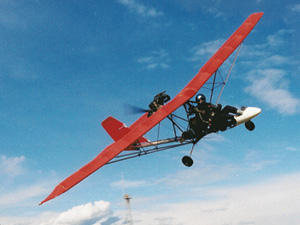
Quicksilver GT 400
If the name Quicksilver doesn’t ring a bell, you haven’t been paying attention. This company is a longtime contender in the sport-flying arena, having started with ultralights in the 1970s and moved into Experimental/Amateur-Built kits. The company has two different series, the MX with an open cockpit, and the GT with a partially or fully enclosed cockpit for cooler climes, and some 14,000 aircraft have been sold to date, the company says.
The GT 400 is a high-tapered-wing, single-seat, pusher ultralight-type design. In the standard configuration, power comes from a 40-hp Rotax 447 with gear drive, though the Rotax 503 is an option. Empty weight is 276 pounds, and gross is 570 pounds. Climb is listed at 1000 fpm, and cruise at 75% power is 72 mph. Fuel capacity is 5 gallons (tank is removable). Flaps are four position, and there is nosewheel steering. Build time is estimated at 70 hours, and dealer assistance with assembly is available. Setup and breakdown times are 15 minutes, Quicksilver says.
Basic kit cost is $16,995 with the engine. At an estimated completed cost of $17,000 to $21,000, the GT 400 easily falls within the limits of our category, and that leaves room for incorporating other options or prettying up the airplane.
The company says the GT 400 has the lowest noise level of all ultralights tested, and the engine mount is virtually vibration free. But with 5 gallons of fuel, you probably wouldn’t take flights long enough for noise or vibration fatigue to be a factor. Still, with the ease of setup and breakdown, and the quick build time to begin with, this design will have you flying in no time, with easy stowage when you’re not.
www.quicksilveraircraft.com
951/506-0061
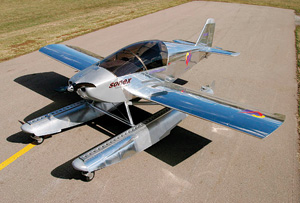
Sonex Aircraft Sonex
Sonex Aircraft is another company that prides itself on providing economical solutions for homebuilt pilots, and it has a long history in the industry. Founder John Monnett has originated many designs, among them the Sonerai, Monerai sailplane and the Moni motorglider, and he has 25 years of homebuilding and restoration behind him. He was inducted into the EAA Homebuilders Hall of Fame in 2001.
The Sonex is markedly different from some of the other aircraft in this group in that it is an all-metal, two-place low-wing monoplane that can accommodate engines of 80 to 120 hp. The three recommended options are the 80-hp AeroVee, the 85-hp Jabiru 2200 or the 120-hp Jabiru 3300. The Sonex meets the Sport Pilot/LSA requirements and can be configured as a tailwheel or trigear. It can also be built from scratch using plans.
Gross weight with the AeroVee is 1100 pounds, with a useful load of 480 pounds. Cruise is listed as 130 mph. Service ceiling is 16,000 feet. The basic kit price is listed as $25,524 including engine. Build time is estimated at 600 hours.
Two seats, higher service ceiling, faster cruise, more fuel capacity, metal monoplane construction and the option of installing a larger engine make the Sonex closer to what many pilots consider a traditional airplane, and the kit gives builders a great deal of flexibility. But construction will take significantly longer and be more involved than some of the other designs in this category, especially if building from plans, and operating costs are likely to be higher than with some of the ultralight-type aircraft we’ve discussed. Those are trade-offs many builders shopping in this price range seem eager to accept.
www.sonexaircraft.com
920/231-8297
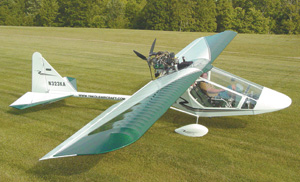
The New Kolb Mark III Xtra
The New Kolb Mark III Xtra, shortened to M3X in the company’s parlance, is an elemental airplane. Two joyriders sit shoulder-to-shoulder in an enclosed pod beneath a fabric-covered wing. Behind their backs is a Rotax 912S of 100 horsepower. A folding tail and clever wing pivots allow the M3X to be trailered to the airport; setup is reported to take 15 minutes.
The 912 is a large chunk of the total outlay, but it may be possible to find a used 912S or downgrade to the straight, 80-hp 912, which is about $2500 less expensive compared to new engines. To make the M3X fit into our budget, you’ll have to choose sparingly (if at all) from the options list. The basic kit is $12,814 plus $1325 for a covering kit. If you can find an engine inexpensively, relatively speaking, you might opt for one of two quickbuild options; the basic at $3695 or including prefab ailerons and flaps for $3945.
When you’re done, you’ll have a sprightly taildragger capable of 78-knot (90-mph) cruise speeds. With 10 gallons, range is somewhat limited, but that’s almost beside the point. Because it comes in under the weight and stall-speed limits for LSA, the M3X can be flown by a Sport Pilot.
www.kolbsport.com
606/862-9692
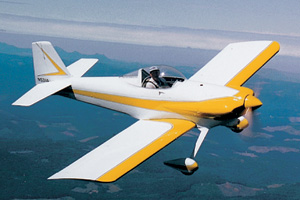
Van’s Aircraft RV-3
Hey, what’s this airplane doing in here? Everyone knows you can’t really build an RV for cheap. Well, that’s not quite true, though we’ll admit that you will be doing a prodigious amount of scrounging to make this work at the $35K limit. Van’s own Cost Estimator puts the low end at $36,425 based on finding a good used Lycoming at $12,000. But, c’mon…you can do better than that.
Why the RV-3 and not the two-seat RV-4? Well, the -4 is a slightly more expensive kit, and its greater weight gives the RV-3 the advantage on a smaller, less expensive engine. To make the price limit, you’ll be working with a basic kit, no quickbuild components, choosing a wood fixed-pitch prop, polishing your stunning metalwork instead of painting it, shopping the corner booths at Oshkosh for used instruments and raiding the local Boater’s World for seat cushions.
Does this make the RV-3 any less a hoot? Not at all. The single-seater is perhaps the purest RV. Light, agile, intimate and quick: a reputed 160 knots (185 mph) on 125 hp and almost 200 mph on 150 hp. With 30 gallons of fuel, you can actually travel quite a distance with a smaller engine, just don’t expect to pack a lot.
www.vansaircraft.com
503/678-6545
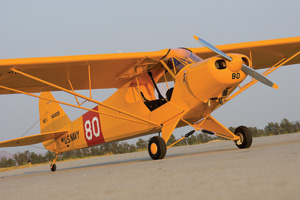
Wag-Aero Sport Trainer
It’s true: Building a Wag-Aero Sport Trainer, a fairly faithful example of the venerable J-3 Cub, for an all-up cost of $35,000 is going to be a challenge. We’re not denying it. The basic kit is $16,000, though if you work through the Wag-Aero catalog, you’ll see that the airplane is offered in many forms and courses. You can order the fuselage structure in pieces, as a tack-welded assembly and as a finish-welded assembly. (Prices range from $2500 for all the bits and pieces to $9175 as a completed assembly.) Add up the cost of the major subkits, including pre-made wingstruts, wing components and basic firewall-forward items, and you’re at $22,000 give or take. That doesn’t leave a lot to complete the airplane, but for the careful shopper it will be enough…just.
One of the strengths of the Sport Trainer is its similarity to the Cub, so many components from the Piper will fit the Wag-Aero, opening up alternative sources including the boneyard. What’s sure is that you’re going to find your engine there: To make a project like this work, you’ll need to find a run-out C-series Continental (up to and including the O-200) and do the rebuild yourself. Or you might find one that’s been in a Cessna 150. Add another $3500 for covering, run minimal instruments for day-VFR, and you’re there. Where? In a nostalgic, 100-mph, low-wing-loading pleasure craft.
www.wagaero.com
262/763-9586
